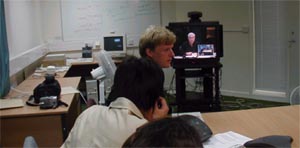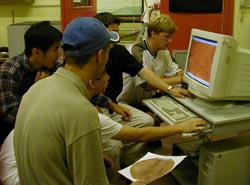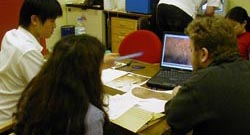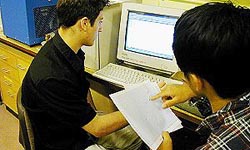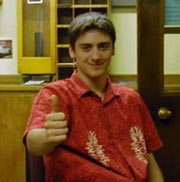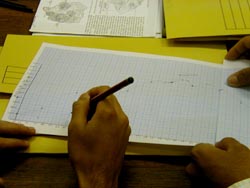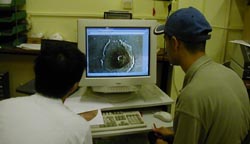Home | About the
Space Science Team | Before | During
| After | Student
Presentations | Visual Tour
Publications | More
Links and Resources | Site Map
- Day 1 -
Movies: Earth Volcanoes | Earth Volcanoes 2 | Mars Impact Theory | Mars Impact Theory 2 | Earth Plates
Please email Steven.Gutierrez@grc.nasa.gov for accessible version of videosi.
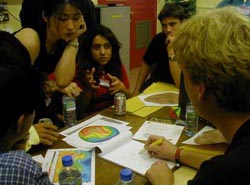
ii.
[The following was sent just after our first video connection. Some pauses were required to allow for translation of my remarks into Japanese and German. This posed no real problem, however. I think that the teams on both sides of the Atlantic were extremely impressed with one another. JCK]
At 11:45 AM 07/23/2001 -0400, LAWRENCEHX@aol.com wrote:
Dear Joe,
I have just "found" a computer, minutes after your inspirational final remarks. Many thanks for this. The group is sitting behind me as I am writing, working hard on many aspects of the project.
Carsten is a gem. We also have Stu, his friend, so the team is growing. As we mentioned, Professor Steve Sparks gave them a short introduction to terrestrial vulcanology, so that they all started at roughly the same point.
I shall e-mail you some of the JPEGS as soon as we get back to the Porter's Lodge, so that I can download the pics into my laptop.
Many thanks for your patience while we translated for the Japanese students. I was aware that this is not your usual format for a conference, but we are learning together.
More when I have caught my breath.
Warmest regards to you all,
Lawrence
iii.
Date: Mon, 23 Jul 2001 15:39:58 -0400
To: LAWRENCEHX@aol.com
From: Joseph C Kolecki <Joseph.C.Kolecki@grc.nasa.gov>
Subject: Re: From the Physics Department at Bristol
Hi, Lawrence,
I am glad that this morning [10:00 - 10:45 a.m. EDT, 3:00 - 3:45 p.m. Bristol time. JCK ] worked out for everybody. I thought that the translations were very interesting--especially the ones from English to Japanese: I cannot imagine two more different languages!
We were delighted to meet with all of you, and we look forward very much to seeing the students become involved with their questions and comments. You certainly have a great deal on your hands, but you/we are accomplishing something new and unique! Again, our best hopes and wishes go with you!! See you tomorrow.
Joe
(P.S. I am available for e-mails should the need arise.)
- Day 2 -
Movies: Q&A1 | Q&A2 | Q&A3 | Q&A4 | Q&A5
[Good morning in Japanese]i.
At 11:15 AM 07/24/2001 -0400, you (LAWRENCEHX@aol.com) wrote:
Dear Joe,
We are now in Earth Sciences, where the team members are back at work developing their ideas still further.
Thank you for your full and clear explanations. You are firing up the team's enthusiasm very effectively indeed.
We will try to tutor the Japanese students in English a bit, so that you can understand their questions, but they are SHY as well as new to English...Their research skills are good.
We plan to use the document camera more tomorrow to discuss actual Martian features, so that the students can develop different skills.
I am delighted with the way the project is developing. Thank you for your inspirational support and a kindness that we feel, even through the technology.
Lawrence
ii.
Date: Tue, 24 Jul 2001 18:56:59 -0400
To: LAWRENCEHX@aol.com
From: Joseph C Kolecki <Joseph.C.Kolecki@grc.nasa.gov>
Subject: Re: From the Physics Department at Bristol
Lawrence,
You and your team are entirely welcome. Tell the students that they need not be shy. WE are all fellow travelers in a world that is eternally new and challenging to us - whether we are age 15 or 50. They are entirely free to agree or disagree with anything and everything I say. I neither have nor know many answers. (No scientist does, if he or she wishes to be perfectly honest about it!) The only thing that they are NOT free to do is to accept ideas without first [severely] questioning them.
Your students are as much an inspiration to us here at NASA as we are (hopefully) to them. They are bright, eager, full of all the stuff that makes an Isaac Newton or an Edmund Halley emerge, bright and luminous, at an early age, and then continue to shine throughout their lives and on into all the new generations that follow.
Tell them to consider us [here at NASA] as their colleagues, fellow explorers, rather than mere mentors. We are all tackling an area that is largely unknown. The fun of it is that we can share our ideas across national boundaries, cultural boundaries, and even language boundaries. Their language skills are FINE as they are. Communication is never easy, but GOOD communication is ALWAYS worth the effort it takes for the respective parties to understand each other. If world political leaders could do as well, we would not have all the messes we currently have, and the News Media would either have to retire, or else find something more optimistic to report!
Ciao!!!
Joe
iii. (a.)
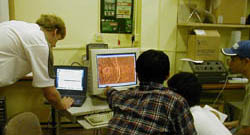
Date: Tue, 24 Jul 2001 12:21:56 -0400
To: LAWRENCEHX@aol.com
From: Ruth A Petersen <Ruth.A.Petersen@grc.nasa.gov>
Subject: Fwd: Today's videocon
Cc: Joseph C Kolecki <Joseph.C.Kolecki@grc.nasa.gov>
Status: U
Carsten
Here are Joe's responses to the questions he wanted to investigate further. Hope this helps! See you tomorrow.
Ruth
iii. (b.)
[The following is a set of responses to questions asked by the students during our first video connection. The actual questions may be obtained from the videotapes. JCK]
Hi!
The question of Martian magma chemistries is still largely unanswered. So is the question of formation of such Provinces on Mars as Tharsis. I have before me a reference that argues a relatively young age for Tharsis. No numbers are given, and the idea is based upon the physical conditions in and around Tharsis.
Again, the students must examine ALL possibilities. The best way to test any theory is to try to tear it apart, not to try to prove it. If the theory withstands repeated attacks and counterarguments, then it is more likely to hold some truth. The impact theory is only one of many, connecting various features on Mars. Remember: We still do not know whether or how these features might really be connected. In their further thinking, the students should try to find as many counter-examples and alternative ideas as they are able.
As to the question regarding subduction zone formation: I do not believe that Tharsis is or was a subduction zone. The overall elevation of the region would seem to argue against this idea. But...making a comparison between Tharsis and known terrestrial subduction zone characteristics might prove to be very enlightening!
Now, here are some additional web sites that have good information--including animated sequences!
(Sites open in new window)
http://ltpwww.gsfc.nasa.gov/tharsis/mola.html
http://ltpwww.gsfc.nasa.gov/tharsis/volcano.html
http://cmex.arc.nasa.gov/MarsEssy/intro.htm
http://www.solarviews.com/eng/marsvolc.htm
The last reference is a sample-return workshop held at NASA/JSC in 1996. It has a lot of compositional information derived from various sources, including meteorites that originated on Mars.
Best regards,
Joe Kolecki
iv.
From: Carsten Riedel
Date: Tue, 24 Jul 2001 17:14:10 +0100
To: Ruth A Petersen <Ruth.A.Petersen@grc.nasa.gov>
Subject: Projectiles and fax numbers...
Cc: Joseph C Kolecki <Joseph.C.Kolecki@grc.nasa.gov>, LAWRENCEHX@aol.com
Status: U
Hello, Ruth and Joe,
Good to hear that there is a positive echo from your side. I forgot about the calculation with the projectile, because I was not thinking the students were at it so fast. But since they are following two lines of research, the question came up in a brainstorming session and we will pursue this line later on. We have not yet looked at anything on Mars but Olympus Mons, and further features will only turn up from tomorrow on when they have a look at some more pictures. And probably we should assign names to the volcano types. Till now I tried to avoid geological terms and they rather know the outlook than the names of shield, strata, and other cones. But we'll get there. So, we are okay, and now the fax number:
+44 (0) 117 9253385
Hoping for more sessions like the one today and even better ones,
Carsten
v.
Date: Tue, 24 Jul 2001 19:13:09 -0400
To: LAWRENCEHX@aol.com
From: Joseph C Kolecki <Joseph.C.Kolecki@grc.nasa.gov>
Subject: Re: From the Physics Department at Bristol
Hi, again, Lawrence,
I have an idea: Carsten wrote, earlier today, that the students have not yet learned geological terms to classify the volcanoes by type, etc. So.......Why not have them INVENT terms of their own--descriptive terms, terms based on their observations of structure, size, location, etc., and develop their own volcano taxonomy? (Just think of what the astronomers have done: "Terrestrial Planets," "Gas Giants," and so on. These young people ought to be able to do at least as well with the Martian volcanoes!!!) By making such an attempt, they will become more naturally open to both the possibilities AND the difficulties of taxonomy. Afterward, Carsten can show them how the geologists and volcanologists have actually solved the problem.
Just a thought....
Joe
- Day 3 -
Movies: Rania's report | Adriano's report | Lee's Report | Joe's discussion about reports
i.
Date: Wed, 25 Jul 2001 09:28:31 -0400
To: LAWRENCEHX@aol.com
From: Joseph C Kolecki <Joseph.C.Kolecki@grc.nasa.gov>
Cc: Ruth A Petersen <Ruth.A.Petersen@grc.nasa.gov>
Hi, Lawrence,
Here are some more useful URL's.
http://www.solarviews.com/eng/tervolc.htm
http://www.star.le.ac.uk/edu/solar/tervolc.html
http://cass.jsc.nasa.gov/publications/slidesets/hawaii.html
http://Marswatch.tn.cornell.edu/rsm.html
Joe
ii.
Date: Wed, 25 Jul 2001 11:42:15 -0400
To: LAWRENCEHX@aol.com
From: Joseph C Kolecki <Joseph.C.Kolecki@grc.nasa.gov>
Subject: One more URL...
Cc: Ruth A Petersen <Ruth.A.Petersen@grc.nasa.gov>
Hi, again!
Here is one more URL-- it features the book by Greeley and other resources.
http://volcano.und.nodak.edu/vwdocs/vwstore/books/c.html
Joe
iii.
[The following correspondence occurred after the students' first presentation to us. They took many of my comments to heart, and the response was absolutely outstanding! In fact, one of our videographers was amazed to learn that these young people were not college but high school students ranging in age from 15-16 years! JCK]
Date: Wed, 25 Jul 2001 11:04:25 -0400
To: LAWRENCEHX@aol.com
From: Joseph C Kolecki <Joseph.C.Kolecki@grc.nasa.gov>
Subject: WOW!
Hello to all of you at Bristol,
Congratulations! We're all smiling from ear to ear on this side of the pond! I think that we've caught a glimpse of the future of space exploration this morning!!!
Joe
iv.
At 11:24 AM 07/25/2001 -0400, you (LAWRENCEHX@aol.com) wrote:
Dear Joe,
We are now working on a summary of what we have collectively gained ready for a final presentation to you tomorrow. We will add ideas from the URLs and books that you have kindly suggested.
I confirm that we will see you at 3.45 UK time, and that we plan to dial in at ISDN 6. The students say that they think you will look even more distinguished at this speed! But this is only a hypothesis and will need to be tested......
Thank you for your very kind words of encouragement. I do not know if I have mentioned this, but all of the students have been chosen because they come from areas of social deprivation, where university education is not seen as a natural progression for them. Their families have no history of higher education, so we hope that this workshop, together with your warm encouragement and inspiration, will set them off on a journey that is entirely new to them.
So the workshop is particularly important socially as well as educationally. The confidence that the students are visibly gaining is worth all the effort in the world.
Thank you.
Lawrence
v.
Date: Wed, 25 Jul 2001 11:49:32 -0400
To: LAWRENCEHX@aol.com
From: Joseph C Kolecki <Joseph.C.Kolecki@grc.nasa.gov>
Subject: Re: WOW!
[The following was written after re-reading the previous message from Lawrence. JCK]
Lawrence,
I also started out with some very serious social and family disadvantages. My kind is usually assumed slated to make the skids or worse. But...I had a dream, and the dream was Mars. Please tell your students that, with perseverance and faith, they can climb above their respective situations--they can even touch the sky! It isn't easy, but it is certainly within the compass of human reach. Tell them that they are interacting with one whose life has become living proof of that statement!
Joe
vi.
[Lee was one of the students in our group. In the following letter, I have placed my remarks between paragraphs in Lee's letter. This is how I originally responded to him. JCK]Date: Wed, 25 Jul 2001 16:53:38 -0400
To: LAWRENCEHX@aol.com
From: Joseph C Kolecki <Joseph.C.Kolecki@grc.nasa.gov>
Subject: Re: From Lee
Hello Joe,
This is Lee here. I have studied Mars along with the rest of the group, but have somewhat drifted away from the group's focus in my own spare time. I have spent a lot of time thinking about the theory that you suggested. Though I did agree with it in some way when I heard it, I felt that there had to be something wrong with it. So I began looking for faults. I decided to look for some evidence of plate tectonic activity, but could not find any, of recent date at least. What I did find was some evidence of some planetary movement much like that of the mid-Atlantic ridge here on Earth, but it looks dormant at the moment.
Hi, Lee,
The best use of a "Naive" theory (properly so-called) of the type that I suggested to you at the beginning of the week is as a seed crystal or catalyst for stimulating new ideas. Scientists advance them all the time in a process called brainstorming, then pan through their results to see whether they can find any gold nuggets. Sometimes the nuggets are there, and sometimes not. Einstein developed much of his thinking in this manner. He is reputed to have, "Toppled [his] house of cards," on more than one occasion. You are carrying your thinking forward in a similar manner. Bravo, Lee! You have the spirit of a true scientist!
Plate tectonic activity on Mars was not known to have taken place until very recently. The Global Surveyor (currently in orbit around Mars) has revealed a wealth of new data in this regard. I like the fact that you are combining impacts, moving plates, hot spots, and so on. This kind of conjunctive thinking lies at the very heart of hypothesis building and leads to eventual experimental work. Ours is a world of connections. You are making valuable connections in your present thinking.
I have seen some magnetic patterns along the planet, and have concluded that they are aligned with the Marineras Valley. Thus I have concluded that this does in fact support your theory, and does not argue against it, as these movements would have occurred a long time ago. So the impact shock waves would have caused the formations as seen today, but not necessarily caused them by themselves.
What kinds of patterns have you seen? Magnetic signatures do not always leave visible evidence, but, rather, evidence that must be gained through the magnetic field using a magnetometer, or related instrument. How does the magnetic signature support an impact theory? Your logic seems a little incomplete here.
Also remember: There is a difference between "Supporting" a theory and "Not arguing against it." It is possible to have a situation in which an idea is NEITHER supported nor argued against. Logic, here, must cut through these matters with a keen edge--no stone left unturned, no statement left unqualified.
The theory that you believe in suggests that the shock waves travelled through Mars and caused the bulge upon the Tharsis Montes. However, I have noticed that the three volcanoes along Tharsis Montes are in line, just like those of the Hawaiian chain. I believe that these are in fact older than the bulge itself, and that Olympus Mons is younger than the impact crater. Following this, I have taken care in formulating a theoretical idea.
Your observation of placement is excellent. Here, you grasp something that might seem so obvious as to not merit a second look. The fact that you DO give it a second look is much to your credit!
Why are the three volcanoes necessarily "older?" I believe that you are arguing for independence between the three line volcanoes, the bulge, and O. Mons. Independence might imply differences in age, differences in processes of generation, and/or many other things. Be careful, here, not to overstate your case.
Several investigators have suggested that O. Mons is a recent feature whereas Hellas is more ancient. Provided that you cite your references here, you are on solid ground.
Additional comment: In formulating your theory, you may make conjectures about relative ages, if you feel that there is substance added. Just be sure to remember where the conjectures lie. Here, permit me a brief excursion into scientific logic: The more conjectures (X, Y and Z) you place in series (i.e., "If X, and if Y, and if Z, then W.") the more you reduce the probability that your conclusion (W) is correct. In logic, statements connected with "AND" have their probabilities multiplied. Since these probabilities are less than or equal to one, odds are that their product is very, VERY much less than one. Always bear this idea in mind when doing conjectural thinking. Quite often, verifying a conjecture becomes the essence of an experimental investigation!
I have noticed that Olympus Mons is not upon a bulge, but that the three volcanoes are. Also, there is a crack in the planet surface near the bulge. Before I explain my idea, I think it is important for a little background knowledge to be explained.
Background info is ALWAYS necessary in a scientific argument. Good work!
The hot spot volcanoes on earth are all in a chain, (the Hawaiian islands) and so are the three volcanoes on planet Mars.
You have just taken a leap into "Comparative Planetology." Nice step!!!
So I am suggesting that these volcanoes are in fact hot spot volcanoes. However, the plate that they would have been on would have been moving very slowly. This would explain why they would have grown so huge.
Nice connection. Why do you think that the plate was moving slowly? Be careful of circular logic here: i.e., "The volcanoes are so huge because the plate was moving slowly, and the plate must have been moving slowly because the volcanoes on it are so huge." I am not accusing you of circular logic here. Please do not misunderstand; but I have seen many a professional fall into just such a trap! This is just another piece of 'pontification' on my part!!! :-)
Also, when they would have erupted, the lava would have cooled extra quickly due to Mars' harsh cold atmosphere.
...assuming a harsh cold atmosphere at the time of eruption. Probably not a bad assumption...
But what has this got to do with Olympus Mons? If we look at Olympus Mons, it is not entirely 180 degrees from the impact sight, and was caused by the reasons explained by you. But I have tried to think of reasons why along side the reason said to be the impact energy travelling outwards. One reason is that, if plate tectonic activity were evident on Mars at an earlier date, then a weak point in the planet interior would have aided the construction of today's features.
Excellent! I like the progression of your thinking here. If there were a major fault system in and around Tharsis, some sounding experiments with a lander rover mission might just be able to detect them. If successful, a major contribution would have been made to our knowledge of this important region of Mars.
I am suggesting that shock waves sent out from the impact would have caused sudden movements in the Martian interior near Olympus Mons, causing some magma from the core to raise up to the surface, causing a bulge.
[N.B.: Words like "sudden" are usually avoided since they cannot be easily quantified. Remember that everything you say much eventually be turned into numbers--either the results of a calculation, a measurement, or most likely both.]
Greeley suggests a similar set of phenomena. He speculates about there being either a hot spot under Tharsis, or increasing gas pressure because of the accumulation of thermal energy [from deeper interior sources]. Do you remember the other day when someone asked whether water would affect the volcanoes? Well, steam might very well be a component of a deep subsurface gas pocket!
However, it is evident that the bulge has appeared near the three volcanoes mentioned above. So why was Olympus Mons formed? I have thought that it was formed because the magma from the hot spot down below has found a new way to the surface from the past happenings. In other words, a weak spot was formed from the past plate tectonic activity. When the activity became dormant, these weak points were left undisturbed until the impact happened. After this, the magma from the hot spot area was caused to rise. Then it found its way up to the surface, causing Olympus Mons to form.
OK, Lee, you raise a plethora of good questions here. Your whole argument needs to be carefully thought out and expanded. What kinds of evidence would be required from the Tharsis region to establish the relationships you are suggesting? I would suggest that you consider both landers, rovers, AND orbiters. Several instrument suites might be required to completely determine whether or to what extent these complex relationships are real on Mars. You've turned up some interesting possibilities to pursue here!
But why is it so big? I have also put thought towards this area as well. My suggestion is that this is also due to the fact that the plates are no longer moving. Comparing Olympus and Hawaii, we can see that their characteristics are the same, and their profiles are especially similar.
Good! You've made some more excellent connections here. Now, ask yourself this question: Is there a maximum height to which a volcano can grow depending on the surface gravity of the planet on which it occurs? Mars has 1/3 the surface gravity of Earth. Are the Hawaiian volcanoes at some limit of growth? (I do not know the answer, but one of your colleagues at Bristol probably does...). Is O. Mons at some limit of growth? (Here I can say that Greeley believes it is!)
So Olympus Mons is concluded to be also a form of a hot spot volcano. However, the planetary movements have stopped for some reason, (WHY?) so the plate that Olympus is on is currently stationary. So the magma is (IS or WAS???) building up and up under the mount, as is the same case for the bulge under the three other older volcanoes. So we see a bulge form because the volcanoes are just sitting there and not moving away from the stationary hot spot. Part of the bulge, especially under the three hot spot volcanoes, was caused by the impact shock wave causing the rock to move, as seen in the Newton cradle effect.
Now you sound like the geologists that I met when I was at the Pathfinder Mission Control. (Whew! Nice scenario!) I might throw in some additional info here: There is some disagreement today as to whether Mars is STILL volcanically active. If it is (the minority opinion), how might your ideas be affected?
I believe that Olympus Mons may have in fact grown bigger because the shock waves caused the magma to find a different way up through to the surface by means of a weak point in the interior of the Martian planet. And (I believe) that it builds because the plates are not moving. Also brought to notice was the formation of the trench. There is evidence of magnetic striations in line with the trench (known as Marineras Valley). (Same question here as earlier on this point...) I know that I have mentioned this before, so this will be brief. I just want to bring to mind that this could have been formed in the early age of the planet's life, and then left, once again when the tectonic activity ceased. Nevertheless, it once again widened with shock waves from the impact, causing it to widen and deepen. So what was once before a simple ocean-like ridge is now a deep chasm that is very narrow.
You are suggesting that the Mariners Valley was originally a ridge that either collapsed or spread apart. WOW! I'm afraid that I cannot help much on this one pro or con. I have never studied the Mariner's Valley. But, your point IS very interesting. If you study photos of the M. Valley, you will see that it is punctuated by immense regions of crustal collapse. I do not know what the significance of these regions is. Please ask one of your mentors at Bristol. I would enjoy being copied on anything you might learn in this regard.
As a conclusion, I am saying that the formations on Mars, apart from the bulge and Olympus Mons were there before the impact, but had risen due to the impact causing magma to rise. Maybe the magma rose through weak points in the interior that had become excited by the impact shock waves, or maybe the magma rose in some other way.
Lee, you have come a long way in your thinking over the past few days. Congratulations on a job well done. Whatever you do, KEEP THINKING, make notes, begin a series of correspondences with your friends at Bristol, with me, amd with anyone else in research if you are able. Do some reading on mathematical and scientific logic. I believe that you've got the mind to pick up the intricacies easily. You're going to make a dynamite scientist if you keep at it ... so... PLEASE KEEP AT IT!!!!!!!!!
I would like to take this opportunity to thank all those who take their time out of important work, thank you very much. I would especially like to thank Joe at NASA for his time in working with us here, and I would like to thank Eric for running this course and Lawrence for helping the course. May special thanks go to Stu and Carsten here at Bristol University, for they have helped me and inspired me a lot. Please forgive me as I do not (know) or have forgotten people's surnames.
This whole experience has also been one of the great highlights for me!!!
Thank you once again.
Lee Parsons
Best regards --- and Godspeed! Joe
vii.
[I was extremely delighted to receive this photograph of Lee!!! JCK]
At 04:13 PM 07/25/2001 -0400, you (LAWRENCEHX@aol.com) wrote:
Mugshot attached.
viii.
Date: Wed, 25 Jul 2001 16:58:47 -0400
To: LAWRENCEHX@aol.com
From: Joseph C Kolecki <Joseph.C.Kolecki@grc.nasa.gov>
Subject: Re: A picture of Lee
I'm going to save this picture and watch for Lee's face to reappear in some future publication on Martian volcanology. Note to Lee: You had better follow through on this, Lee, because you've got a friend waiting and watching "just the other side of the pond!!!" (A little "Americanism" there... :-))
Joe
ix. (a.)
Date: Wed, 25 Jul 2001 15:42:41 -0400
To: Joseph.C.Kolecki@lerc.nasa.gov
From: Ruth A Petersen <Ruth.A.Petersen@grc.nasa.gov>
Subject: Ask a Geologist Web Site
Joe
Do you think this would be a worthwhile URL to send to Lawrence and his students since we couldn't find a "live" geologist?
http://walrus.wr.usgs.gov/docs/ask-a-ge.html/
Ruth
x. (b.)
Date: Wed, 25 Jul 2001 17:10:12 -0400
To: LAWRENCEHX@aol.com
From: Joseph C Kolecki <Joseph.C.Kolecki@grc.nasa.gov>
Subject: Fwd: Ask a Geologist Web Site
Hi, Lawrence,
Ruth found this site. It comes from the U.S. Geological Service. Your students might like to check it out!!
Joe
- Day 4 -
Movies (Summary): Toshiyuki | Akiro | Rania | Adrian | Lee | Joe discusses the day | Final Goodbye
i.
[The following exchanges were made after a stunning presentation from the Bristol students. Everybody - on both sides - was on a high when it was over! JCK]
At 04:48 AM 07/26/2001 -0400, Lee wrote through Lawrence (LAWRENCEHX@aol.com):
Thank you very much, Joe!
I do intend on pursuing a career in science, but not one in planetary content. I love cosmology, and follow Stephen Hawkings' work closely. I wish to make a top cosmologist someday, or just a scientific reporter on all things scientific.
Nevertheless, I have really enjoyed studying Mars over the past few days, and would definitely like to keep in touch with everyone here at Bristol, and especially with you and any one else I can. I would like to study Mars in my spare time after today, I feel as though I have taken a real interest to it.
I really appreciate your response to my e-mail. I found it most helpful, and I want to discuss the points made by you with the people here at the university in Bristol. Thank you once again, Joe. Also, could I please have your e-mail, as I would like to keep in contact with you in the not too distant future.
And Godspeed to all of you on the other side of the pond too...from Lee.
:)
ii.
Date: Thu, 26 Jul 2001 09:08:32 -0400
To: Lee through Lawrence (LAWRENCEHX@aol.com)
From: Joseph C Kolecki <Joseph.C.Kolecki@grc.nasa.gov>
Subject: Re: A picture of Lee
Lee,
Go for it! I once met a Shuttle astronaut whose favorite saying was, "Reach for the stars!" If you reach out, Lee, you will certainly touch them!!!
My e-mail is:
joseph.c.kolecki@grc.nasa.gov
PLEASE feel free to write whenever the spirit moves you!!!
Joe
iii.
At 12:18 PM 07/26/2001 -0400, Lawrence (LAWRENCEHX@aol.com), Rania, and Adriano wrote:
Dear Joe and all the people in the room there!
Many thanks for your kind support and encouragement. I have really enjoyed what was a very busy and demanding week.
I am now working on a new idea that will incorporate the Science through Drama workshop that has also taken place here. Watch this space!.......
Lawrence
Hi Joe,
Rania here, I'd like to tell you how immensely grateful I am to you and your team. You have been truly inspirational in your motivation and encouragement. This workshop has given me an idea of what higher education and a career in science would be like, and I will go back to school full of anticipation of such a path. I am now very excited about what the future holds and what I, and my new friends in Bristol, can go on to achieve.
I hope to keep in touch with you and will most definitely research further into this field.
Many thanks once again.
Rania Kashi
Dr. Joe,
I'm absolutely delighted to tell you that I'm glad to have taken part in this project. I guess we have showed to the world that it is possible and beneficial to share new information and work together. An unforgettable experience, a successful mission itself. Please send my acknowledgements to all our colleagues that took part at NASA. Thanks again and hopefully we will continue to keep in touch. GODSPEED
ADRIANO SILVA
This (is) Lawrence again, signing off for the moment. The students now have to prepare a PUBLIC presentation of their work....
iv.
Date: Thu, 26 Jul 2001 13:18:39 -0400
To: LAWRENCEHX@aol.com
From: Joseph C Kolecki <Joseph.C.Kolecki@grc.nasa.gov>
Subject: Re: Thanks from us all
Dear Lawrence, and all our friends in Bristol,
It was our pleasure to have shared your week with you. Best wishes from all of us at NASA. Keep those lights burning! Each of you has something unique to give to the world.
Godspeed!!!
Joe Kolecki
v.
From: Lee Parsons
To: Joseph.C.Kolecki@grc.nasa.gov
Date: Thu, 26 Jul 2001 20:39:03 BST
Subject: Thank you
Hello Joe,
It is Lee here again. I would just like to say a big thanks to all those at NASA who helped make this experience helpful. I have truly enjoyed the study that we have done together, and I hope that we can stay in contact.
I feel as though my eyes have been opened up to a whole new world that is the world of Mars, and would like to study it further...but I would need to ask of some help from you and whoever else can provide help. I would like to be especially kept up to date with the discoveries about Mars, if that would be possible with you folks over there at NASA.
I feel as though I have fallen in love with the Planet; it has so many wondrous features, and I know that we here have really only touched the tip of the iceberg.
I would also like to thank you personally, Joe, for the things that you said about a career in science. I felt that it was very inspiring, and I will definitely pursue a career in the field of science, even if it means that I have to take it up as a hobby as a result of me being rejected from university.
Well, thank you for such a great time, may I take this opportunity to wish you Godspeed with the project on Mars, and I hope to hear from you soon.
Lee Parsons
- Day 5 -i.
Date: Fri, 27 Jul 2001 13:45:41 -0400
To: Lee Parsons
From: Joseph C Kolecki <Joseph.C.Kolecki@grc.nasa.gov>
Subject: Re: Thank you
Hello, Lee,
Nice to hear from you. I assume that, by the time you receive this letter, you will have already made a successful presentation to your peers at Bristol.
Judging from what we saw of you and your group here, you had an experience very much like that of any group of scientists working through a real-life problem. I was reminded, at several points during our sessions, of my 18 days at the Jet Propulsion Laboratory, after we had successfully landed the Pathfinder Mission on Mars. We worked around the clock, had all sorts of little meetings and conclaves, made presentations, and tried our best to use our existing knowledge to interpret the new data that was coming down daily from the Ares Valles on Mars. It was both a heady and an exhausting experience. When I returned home, I went through a period of time in which I received calls from all over the country at almost all hours of the day and night. I had demonstrated an important point, you see, and, suddenly, I was regarded as some kind of an expert!
You and your group have experienced something similar this week, Lee. I hope that those of you who want to will go on into professional science. We need people of your caliber, especially in the world of exploration that is opening up throughout the solar system and beyond. And the best part of all of it is that you get to meet some of the neatest people anywhere and everywhere across the globe!
Best wishes, Lee. Keep in touch.
Your friend and colleague in America,
Joe
ii.
At 02:40 AM 07/27/2001 -0400, you (LAWRENCEHX@aol.com) wrote:
Dear Joe,
One of the aims of the Workshops, here at Bristol University, was to give a combined group of sixty young people, from across Japan and from the United Kingdom, a new view of themselves as potential scientists, and an ambition to succeed at the highest level. I am struggling to find words to express our gratitude to you and your team for your help in this venture.
Our particular group, in Space Science, at the Department of Earth Sciences, has had the most wonderful week, and I truly believe that the students' lives have been transformed by it. You have some evidence of this already in the e-mail that we sent just after the final presentation session.
The support you have given, the personal words of encouragement, and that rare combination of warmth and professional rigor which we now see as the hallmark of you and your team, have given these youngsters a new sense of confidence and pride, both in themselves and in their achievements. You will have felt this as the conferences unfolded. I am grateful to you for lending us the legendary NASA name, proud of what we have achieved together, and joyful at the success of the students. "Thank you" does not even come close to it.
Today, Friday, our group has a public presentation to give, to the other nine groups and to many visitors, using PowerPoint, and will later word-process a full written Report, which of course we will send you.
Eric and I have only recently joined forces, and would both be delighted to work with you on future projects: we are hoping that this is just the beginning of many exciting ways of using the new technologies to advance the cause of science education, and to inspire young people.
I believe that during this week we have together taken another useful step.
With our warmest regards and thanks,
Lawrence
iii.
Date: Fri, 27 Jul 2001 12:06:21 -0400
To: LAWRENCEHX@aol.com
From: Joseph C Kolecki <Joseph.C.Kolecki@grc.nasa.gov>
Subject: Re: Thanks from us all
Dear Lawrence,
Your kind words and the transformation we all saw in the members of our group say everything! We are proud to have been asked to join forces with you. All of you at Bristol have achieved a landmark in education! May its effects be felt everywhere!!
Yes to further involvement with you - by all means, YES!!!
Joe
Web Related:
David.Mazza@grc.nasa.gov
Technology Related: Joseph.C.Kolecki@grc.nasa.gov
Responsible NASA Official:
Theresa M. Scott



